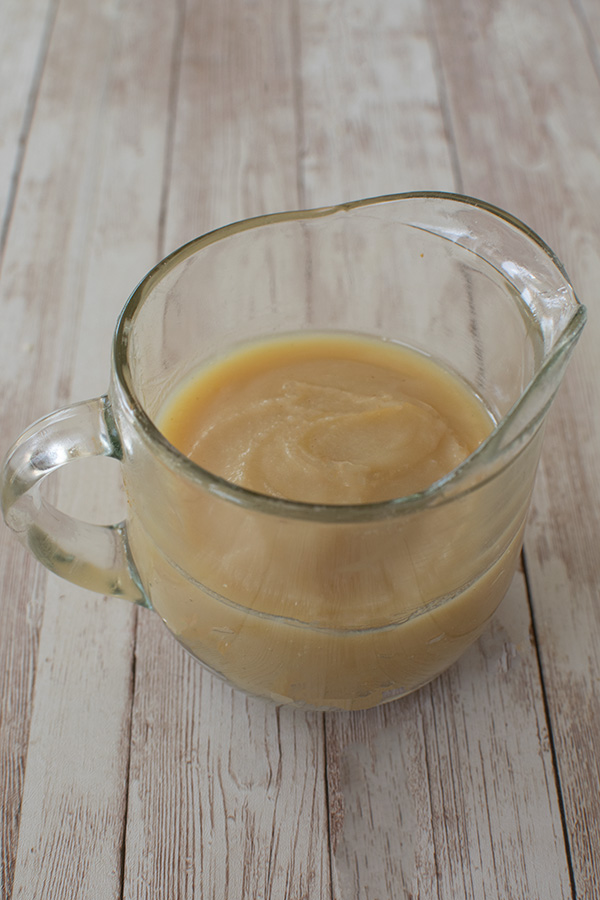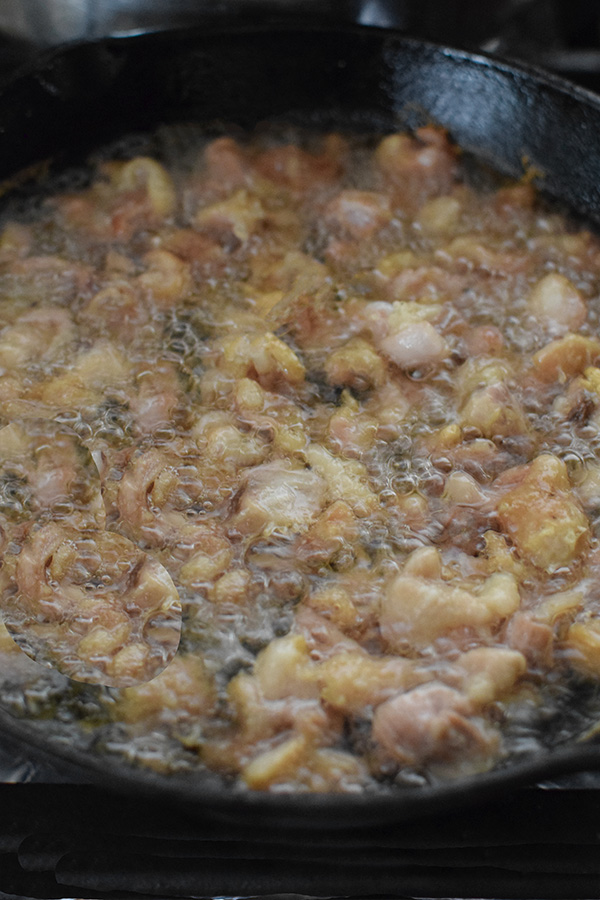Basic Chicken Schmaltz for Passover is a simple and basic recipe for rendering chicken fat to later be used in cooking or even as a delicious spread on matzo.

Basic Chicken Schmaltz for Passover takes little time to make and can last in the refrigerator for a long time. Use to add a little extra delicious greasiness to recipes that require it.
Schmaltz in and of itself is a term for rendered (melted) chicken or goose fat.
Schmaltz is a traditional part of Eastern European (Ashkenazi) Jewish cuisine and is used as a cooking fat in a variety of dairy free foods (especially if one keeps kosher).
Basic Chicken Schmaltz for Passover can also be used as a spread on matzo, especially if one adds salt or other flavors.
The term “schmaltz” is derived from the German verb meaning “to melt”. Today, the term is commonly used in English when referring to chicken fat.
When you hear the term used not in reference to food, know that it is Yiddish slang to mean a kind of mushy sentimentality.
Shmaltz was introduced to the US by Eastern European Yiddish speaking Jews when they ran from European anti-Semitism and immigrated, bringing their cuisine with them.
A by product of the fat rendering product is “gribenes”, which are the crispy pieces of chicken skin left after the melting process. My grandmother used to take gribenes and chop it in when she made chopped liver.

A little of my cooking background
I really wanted to title this blog “If I can make it, anyone can” because, honestly, if I can make it, anyone can.
I never really liked cooking, and when I was single, a meal for me meant grilled cheese, eggs, tuna, or something else that didn’t require effort or time.
When my kids were young, I was still able to get away with preparing only a small variety of easy meals, but the older they got, the more dishes I learned to make at their request.
Still, I insisted on keeping it simple.
Honestly, I never understood why some cooks unnecessarily complicate meals. I have seen recipes that have several ingredients that don’t really seem to add much, if anything, to the dish. So, why bother?
It has always been important to me that whoever eats at my table will have plenty to enjoy, and that includes my kids (I never agreed with the “You will eat what is served or you won’t eat” ideology), and, because I keep it simple, I can prepare a variety of dishes in a relatively short period of time.
I have a philosophy regarding being a great cook: Prepare food according to the tastes of those who will be eating it, and they will love your cooking!
As far as I am concerned, start with the basic ingredients that make the dish what it is, adapt according to taste, and voila! You are an amazing cook!
The bottom line is that while there are certainly delicate recipes out there for specialty dishes, making delicious meals doesn’t have to be complicated or time-consuming. It’s not difficult to impress—just make sure it tastes good.
While some of the recipes on my blog are more time-consuming than others, they are all tried and true, easy-shmeezy!
Of course, one always has to consider the conditions under which they cook. Weather (humidity, heat, cold), different types of ovens, different qualities of pots, etc.—all of which can affect your cooking and baking.
Nevertheless, as I said, if I can do it, anyone can!
Kosher for Passover Pantry Essentials (Suggestion)
As I learned to prepare more and more recipes for Passover, I also learned which basics and seasonings are good to have on hand to have the ability to make a dish on short notice—especially during the holiday—and not have to run out to the store or borrow from a neighbor.
While I will admit that I am not always prepared when one of my kids will ask for eggplant parmesan or something at the drop of a hat (which they have done), I dislike having to postpone making something just because the ingredients needed to make a reasonable meal were not readily available.
So, I maintain a selection of what I consider “kosher for Passover pantry essentials” in my refrigerator and on my shelves during the week of Passover (some of the dry goods I keep from year to year, stored well).
While, of course, most of the essentials will not be needed just for any one recipe, at least some of them are needed for most recipes, and you would be surprised how many recipes can be made just with this list. So, if you make sure to have whatever you use regularly on hand, it can really save you time and effort.
Everyone has their favorite recipes, preferred seasoning, and just whatever they like to use to cook. Your own list should certainly reflect your own cooking tastes and style. Just make sure that everything is Kosher for Passover (KLP) and if you are Ashkenazi, that list will be shorter than if you are not.
Make sure to check with a qualified rabbi if you have any questions.
The following is a pretty comprehensive list of what you can choose from to keep on hand. I keep quite a bit of it.
Seasoning and flavoring:
- salt
- ground black or white pepper
- granulated garlic or garlic powder
- onion powder
- ground cinnamon
- sugar (granulated)
- brown sugar
- chicken consommé powder
- onion soup mix
- various herbs
- additional spices to adapt taste to preference
Misc:
- oil / margarine / butter / cooking spray
- potato starch as a thickening agent
- baking powder
- matzo cake meal (matzo meal, but ground into a powder)
- condiments, such as ketchup and barbecue sauce
- tomato sauce/tomato paste/canned tomatoes—diced or crushed/pasta sauce
- milk substitute (neutral flavor)
We always have eggs in the fridge and onions and potatoes on our shelves (if we were not Ashkenazi, I would certainly keep rice as well).
In addition, having fresh vegetables , such as carrots, celery, bell peppers (red, green, etc), tomatoes (if you don’t want to use canned), etc. can be very useful when putting together a quick but delicious meal.
It’s also a good idea to have some ground meat or chicken (breast, ground, or in parts) in the freezer for anyone who likes meat dishes in a snap.
Why are these pantry essentials beneficial to have on hand?
Personally, having the above ingredients in my kitchen is very advantageous, as I make a variety of dishes and use most of the items on the list regularly.
Whether or not buying a bunch of herbs, spices, etc., before you know what you are going to make for the week is workable for you depends on your own personal preference.
Of course, the more you cook and the more varied your recipes, the more you will use, and the more you will need.
If you plan your meals ahead for the week, you will be prepared with whatever else you might need that you wouldn’t even normally keep in your Passover pantry.
If you do decide to keep them over from year to year, I would only do so if they can be sealed well (or better yet, stored in the freezer), because not only can weather have an effect on some of the spices and on the chicken consommé powder, but you will be surprised to know just how clever moths are at getting into sealed bags and how hot red pepper powder can attract little black bugs – YUCK!
Food on Passover
Torah-observant Jews do not eat chametz (the fermented products of five grains: wheat, spelt, barley, oats, and rye).
In addition, Torah-observant Ashkenazi Jews do not eat kitniyot (or kitniyos as pronounced in Ashkenazi Hebrew). These include legumes, corn, rice, and similar foods that were deemed forbidden to eat by rabbis in the medieval period and are still not eaten today. Sephardi and Mizrachi Jews do not follow this tradition.
Many observant Ashkenazi Jews will not even eat the derivatives of these kitniyot, while others do (each family holds their own traditions regarding this).
Then, there are Ashkenazim who don’t eat “gebrokts” (or gebrochts).
Gebrokts (gebrochts) means “broken” in Yiddish, and in this case refers to matzo that has absorbed liquid. Not eating gebrokts is observed by many in the Hasidic Jewish community and Ashkenazim who have taken on this tradition where they basically don’t mix anything wet with matzo.
So, things like matzo sandwiches, fried matzo, and even matzo balls are a no-no for them.
There is a joke that sums it all up:
On Passover, we should remember people who have little to eat on this holiday. They are called Ashkenazim.
Over the years, I have learned to adapt “normal” food for Passover so that my family won’t complain about boring, tasteless, or repetitive meals.
I find that having good food and variety makes the week of Passover a very pleasant experience, and I hope this recipe will help make yours just that!
Basic Chicken Schmaltz for Passover

Easy to make-at-home, chicken schmaltz. Great to enhance cooking or spreading on bread or crackers.
Ingredients
- 1 pound chicken skin and fat
- 1 tablespoon water to prevent fat from initially sticking to pan
Instructions
- Chop chicken skin and fat into small. pieces.
- Also, chop onion into small pieces.
- Add the skin, fat, and water to a frying pan that has not been heated and place on medium heat.
- Cook on medium heat until the skin begins to turn a golden brown.
- Remove from heat and strain mixture into a container to separate skin from the schmaltz.
- Let cool.
Nutrition Information:
Yield:
8Serving Size:
1Amount Per Serving: Calories: 257Total Fat: 23gSaturated Fat: 6gTrans Fat: 0gUnsaturated Fat: 15gCholesterol: 47mgSodium: 37mgCarbohydrates: 0gFiber: 0gSugar: 0gProtein: 12g